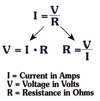PHY 10 - Electrical Circuits Flashcards
(52 cards)
What is electrical current (I) ?
The amount of charge (Q) that flows past a point in a given amount of time (t)

What are the units of electrical current ?
Amps (amperes)
OR
Coulombs/second
How is an electrical current caused ?
By the movement of electrons between two points of significant potential difference of an electrical circuit.
How is energy lost by an electrical circuit ?
Free electrons accelerate towards the positive connection. As they move, they collide with atoms in the substance, losing energy which we observe as heat.
What is an electric current ?
The motion of electrons
What happens to an electrical circuit if the magnitude of the electric potential is increased ?
The current will increase because the electrons will accelerate faster
Describe the concept of joule heating ?
Collisions between electrons and atoms transfer energy to the atoms, which is released as heat.
What are Ohmic conductors ?
Materials such as joule heaters that obey Ohm’s law, V=IR
What is Ohm’s law ?

Describe how Ohm’s law works ?

What is an Ammeter ?
Used to measure the flow of current
What is this ?

An ammeter - measures the flow of current
What is resistance (R) ?
The measure of opposition to the flow of electrons in a substance
What is resistivity (p) ?
The inherent resistive property of a substance, which varies with temperature
What is the equation that includes resistance and resistivity ?

Why does electrical resistance vary with temperature ?
The thermal motion of molecules increases with temperature, resulting in more collisions between electrons which impede their flow.
What are the units of resistance ?
Ohm’s
1 Ohm = 1 volt/ampere

What happens when a positive current flows across a resistor ?
There is a voltage decrease and a power loss.
P = VI = V2/R
Describe how to calculate electrical power ?

What does a resistor look like in a circuit diagram ?

What is this ?

A bulb.
(N.B. This also acts like a resistor!)
Why is a bulb in an electrical circuit treated like a resistor ?
The filament inside a light bulb resists the flow of current, and becomes bright and hot.
The brightness of the bulb depends on how much power it loses.
What are the units of Q (charge) ?
Coulombs (C)
What are Capacitors ?
They are used in circuits to store charge, they are similar to batteries but can discharge much more quickly.
E.g. A flash gun on a camera








